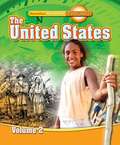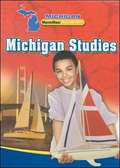 Citizenship, Grades K-3
310840
Citizenship, Grades K-3
310840
|
the editors at Macmillan/McGraw-Hill
|
9780021523665 |
2008 |
NIMAC restricted
Contains images
|
|
 All Together Geography
1097908
All Together Geography
1097908
|
Dinah Zike
James A. Banks
Kevin P. Colleary
Linda Greenow
Walter C. Parker
Emily M. Schell
Irma M. Olmedo
Raymond C. Jones
|
9780021523962 |
2009 |
NIMAC restricted
Contains images
|
|
 All Together History
326195
All Together History
326195
|
Dinah Zike
James A. Banks
Kevin P. Colleary
Linda Greenow
Walter C. Parker
Emily M. Schell
Irma M. Olmedo
Raymond C. Jones
|
9780021523979 |
2009 |
NIMAC restricted
Contains images
|
|
 All Together Economics
1097909
All Together Economics
1097909
|
Dinah Zike
James A. Banks
Kevin P. Colleary
Linda Greenow
Walter C. Parker
Emily M. Schell
Irma M. Olmedo
Raymond C. Jones
|
9780021523986 |
2009 |
NIMAC restricted
Contains images
|
|
 All Together Citizenship
326221
All Together Citizenship
326221
|
Dinah Zike
James A. Banks
Kevin P. Colleary
Linda Greenow
Walter C. Parker
Emily M. Schell
Irma M. Olmedo
Raymond C. Jones
|
9780021523993 |
2009 |
NIMAC restricted
Contains images
|
|
 People and Places Geography
117070
People and Places Geography
117070
|
Dinah Zike
James A. Banks
Kevin P. Colleary
Linda Greenow
Walter C. Parker
Emily M. Schell
Irma M. Olmedo
Raymond C. Jones
|
9780021524006 |
2009 |
NIMAC restricted
Contains images
|
|
 People and Places: History
117213
People and Places: History
117213
|
Dinah Zike
James A. Banks
Kevin P. Colleary
Linda Greenow
Walter C. Parker
Emily M. Schell
Irma M. Olmedo
Raymond C. Jones
|
9780021524013 |
2009 |
NIMAC restricted
Contains images
|
|
 People and Places Economics
117219
People and Places Economics
117219
|
Dinah Zike
James A. Banks
Kevin P. Colleary
Linda Greenow
Walter C. Parker
Emily M. Schell
Irma M. Olmedo
Raymond C. Jones
|
9780021524020 |
2009 |
NIMAC restricted
Contains images
|
|
 Our Country and Its Regions, Volume 2 [Grade 4]
130076
Our Country and Its Regions, Volume 2 [Grade 4]
130076
|
Dinah Zike
James A. Banks
Kevin P. Colleary
Linda Greenow
Walter C. Parker
Emily M. Schell
|
9780021524044 |
2009 |
NIMAC restricted
Contains images
|
|
 The United States, Volume 2 [Grade 5]
70093
The United States, Volume 2 [Grade 5]
70093
|
Dinah Zike
James A. Banks
Kevin P. Colleary
Linda Greenow
Walter C. Parker
Emily M. Schell
|
9780021524051 |
2009 |
NIMAC restricted
Contains images
|
|
 The United States, Volume 2 [Grade 5]
260061
The United States, Volume 2 [Grade 5]
260061
|
Dinah Zike
James A. Banks
Kevin P. Colleary
Linda Greenow
Walter C. Parker
Emily M. Schell
|
9780021524051 |
2009 |
NIMAC restricted
Contains images
|
|
 The World, Volume 2
310611
The World, Volume 2
310611
|
James A. Banks
Kevin P. Colleary
Linda Greenow
|
9780021524068 |
2009 |
NIMAC restricted
Contains images
|
|
 Michigan Studies
652972
Michigan Studies
652972
|
James A. Banks
Kevin P. Colleary
Walter C. Parker
|
9780021536436 |
2009 |
NIMAC restricted
Contains images
|
|
 The United States: Modern Times
534938
The United States: Modern Times
534938
|
James A. Banks
Kevin P. Colleary
Linda Greenow
|
9780021536948 |
2012 |
NIMAC restricted
Contains images
|
|
 Macmillan/McGraw-Hill Treasures Grade 1 Book 1
415980
Macmillan/McGraw-Hill Treasures Grade 1 Book 1
415980
|
Jana Echevarria
Donald R. Bear
Janice A. Dole
Jan E. Hasbrouck
Scott G. Paris
Timothy Shanahan
Josefina V. Tinajero
|
9780021920013 |
2007 |
NIMAC restricted
Contains images
|
|
 Macmillan/McGraw-Hill Treasures Grade 1 Book 2
431308
Macmillan/McGraw-Hill Treasures Grade 1 Book 2
431308
|
Jana Echevarria
Donald R. Bear
Janice A. Dole
Jan E. Hasbrouck
Scott G. Paris
Timothy Shanahan
Josefina V. Tinajero
|
9780021920020 |
2007 |
NIMAC restricted
Contains images
|
|
 Macmillan/McGraw-Hill Treasures Grade 1 Book 3
155740
Macmillan/McGraw-Hill Treasures Grade 1 Book 3
155740
|
Jana Echevarria
Donald R. Bear
Janice A. Dole
Jan E. Hasbrouck
Scott G. Paris
Timothy Shanahan
Josefina V. Tinajero
|
9780021920037 |
2007 |
NIMAC restricted
Contains images
|
|
 Macmillan/McGraw-Hill Treasures Grade 1 Book 5
1021924
Macmillan/McGraw-Hill Treasures Grade 1 Book 5
1021924
|
Jana Echevarria
Donald R. Bear
Janice A. Dole
Jan E. Hasbrouck
Scott G. Paris
Timothy Shanahan
Josefina V. Tinajero
|
9780021920051 |
2007 |
NIMAC restricted
Contains images
|
|
 Macmillan/McGraw-Hill Treasures Grade 2 Book 1
134033
Macmillan/McGraw-Hill Treasures Grade 2 Book 1
134033
|
Jana Echevarria
Donald R. Bear
Janice A. Dole
Jan E. Hasbrouck
Scott G. Paris
Timothy Shanahan
Josefina V. Tinajero
|
9780021920068 |
2007 |
NIMAC restricted
Contains images
|
|
 Macmillan/McGraw-Hill Treasures Grade 2 Book 2
134276
Macmillan/McGraw-Hill Treasures Grade 2 Book 2
134276
|
Jana Echevarria
Donald R. Bear
Janice A. Dole
Jan E. Hasbrouck
Scott G. Paris
Timothy Shanahan
Josefina V. Tinajero
|
9780021920075 |
2007 |
NIMAC restricted
Contains images
|
|
 Macmillan/McGraw-Hill Treasures Grade 3 Book 1
170410
Macmillan/McGraw-Hill Treasures Grade 3 Book 1
170410
|
Jana Echevarria
Donald R. Bear
Janice A. Dole
Jan E. Hasbrouck
Scott G. Paris
Timothy Shanahan
Josefina V. Tinajero
|
9780021920082 |
2007 |
NIMAC restricted
Contains images
|
|
 Macmillan/McGraw-Hill Treasures Grade 3 Book 2
420021
Macmillan/McGraw-Hill Treasures Grade 3 Book 2
420021
|
Jana Echevarria
Donald R. Bear
Janice A. Dole
Jan E. Hasbrouck
Scott G. Paris
Timothy Shanahan
Josefina V. Tinajero
|
9780021920099 |
2007 |
NIMAC restricted
Contains images
|
|
 MacMillan/McGraw Hill Treasures [Grade 4]
85642
MacMillan/McGraw Hill Treasures [Grade 4]
85642
|
Jana Echevarria
Donald R. Bear
Janice A. Dole
Jan E. Hasbrouck
Scott G. Paris
Timothy Shanahan
Josefina V. Tinajero
|
9780021920112 |
2007 |
NIMAC restricted
Contains images
|
|
 Macmillan/McGraw-Hill Treasures Grade 6
260018
Macmillan/McGraw-Hill Treasures Grade 6
260018
|
Jana Echevarria
Donald R. Bear
Janice A. Dole
Jan E. Hasbrouck
Scott G. Paris
Timothy Shanahan
Josefina V. Tinajero
|
9780021920136 |
2007 |
NIMAC restricted
Contains images
|
|
 Reading Triumphs [Grade 2]
126976
Reading Triumphs [Grade 2]
126976
|
The McGraw-Hill Companies
|
9780021920174 |
2007 |
NIMAC restricted
Contains images
|
|